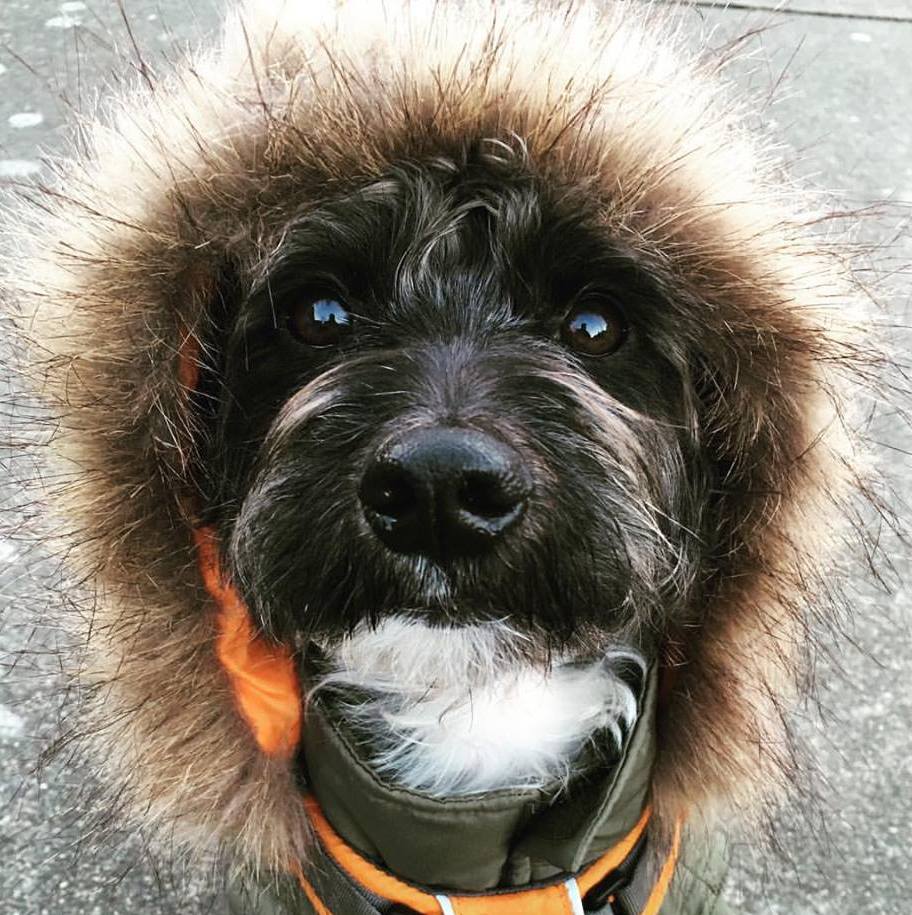

Have you ever run out of cat food in the middle of a blizzard? I did!
Luckily, I did not run out of tuna—the expensive kind for humans—so my cat ate better than usual. This year, I’m going to stock up before the snow flies, and I’ve vowed to keep an extra bag or two on hand. (Plus extra tuna, just in case.)
It’s not too early to think about what you need to do to prepare your pet for winter. You can start now so when the weather turns cold, you’ll be ready and so will your pet! Think back to the last few winters. You will likely remember something you wish you’d done ahead of the holidays, before the year-end rush—something that would have made the season easier, both for your pet and for yourself.
Outdoors
▪ Pet-safe ice melt is always best for outside steps and walkways. Even if your pets don’t come directly into contact with it, you’ll bring it in on your shoes or boots and so will visitors. Buy it now.
▪ Use no ice melt at all where dogs and cats hang out regularly. Shovel those areas instead, if at all possible, and consider using non-chemical means of combatting slippery frozen spots.
▪ Store outdoor furniture indoors for the winter to avoid damage to it and to the lawn or landscaping around it from male dogs lifting legs on it repeatedly.
▪ Redirect repeat leg-lifting by providing an appropriate upright post surrounded by bark to save the lawn from yellow spots in the spring.
Indoors
▪ Collect “dog towels” near the door dogs use to go in and out to your yard and the door they use to go in and out to walk or to get to your car. Those towels will be handy when your dog is covered with snow or has ice stuck between his toes. You can clean him up and dry him off before he goes inside.
▪ If you drive your dog to walk away from home, throw some “dog towels” into your car, too, for after-walk clean-ups!
▪ Put out non-slip matting or absorbent rugs near doors to the outside, to keep snow and ice off your floors and to keep people and pets safe from slippery surfaces.
▪ Set up a kennel near the exit door your pet uses so that you can “send” him directly into it when he is wet or muddy.
▪ Fill the kennel with warm “dog towels” directly from the dryer for that luxury spa experience while Fido de-ices!

Photo by Rubin Dietz-Gilpin
Do you have an ill or elderly pet? You might want to look into some sort of heated bedding for the animal.
▪ There are corded electrical options, which of course require care that the pet doesn’t soil or destroy the bed.
▪ There are non-electrical options, too, including discs that can be heated in a microwave then placed in the pet’s bed, and beds that reflect back the pet’s own warmth, like a pet space blanket.
▪ Whichever you choose, make sure that the covering the pet sleeps on directly is easily washable—ideally, even replaceable if the item is expensive.
Warm Winter Clothing
Now is a good time to be looking for boots for your dog to wear this winter! Check first at your local animal shelters, humane organizations, or rescues that sell pet supplies. You may find the perfect fit for your dog there at a much reduced price because the items have been donated, new or slightly used.
▪ Don’t expect your dog to “take to” wearing boots on the first try.
▪ Look online for videos of positive trainers demonstrating pleasant ways to introduce boot-wearing to previously unshod pooches. (Hint—there may be treats involved!)
▪ Give your dog all the time she needs to accept these new accessories at home before this winter’s snow and ice. Don’t rush the process!
The same is true for introducing any new wearing apparel. Go slowly, giving the animal a chance to look at and sniff, say, a new winter coat, long before you throw it over her body and cinch it up.
What about warm winter clothing for pets to wear inside your house? That depends! Is your dog or cat cold? How can you tell? It’s highly unlikely that, in a centrally heated home, healthy dogs or cats with full coats of fur need to wear sweaters. But if you have a “hairless” cat or “almost hairless” dog, you’ll probably wonder if he’s warm enough even if you don’t see him shivering.
But don’t spend a fortune to find out if your pet would be more comfortable in a cardigan! Thrift stores and other outlets for slightly used and even new pet clothing are the first place to look, not your area’s most high-end pet boutique.
Buy something inexpensive that you think will fit your pet, take it home and wash it, then introduce it casually over time to your pet. Again, not by shoving the pet into the item unceremoniously and hoping the pet doesn’t freak. Take your time, please—no ugly scenes!
I do caution you about leaving wearable items on your pet too long. I’m not talking simply about taking the item off to wash it, which I hope goes without saying should be done frequently. I’m talking about keeping your pet “dressed” in sweaters or the like all the time, even if you switch “outfits” every day. I think it’s advisable to allow your pet to run around “naked” some of the time, too.
▪ Take your pet’s clothing off for daily grooming. Some sorts of fur will become matted under it and will need to be combed and/or brushed out.
▪ Some pets’ skin may react as well. Look closely for lumps, bumps, abrasions, rashes.
▪ Allergies could be an issue. Is your pet reacting to a laundry detergent or fabric softener? If you’re seeing skin issues and you can’t figure out an obvious cause like a sweater rubbing a raw spot, consult your veterinarian before “clothing” your pet again.
Dry Skin
Some pets, like some people, get dry skin in cold weather. Solutions that might work for people aren’t always practical with pets—moisturizing lotion, for example, does not work as easily for a husky as it does for a human.
Unless a humidifier solves your pet’s dry-skin issues, it’s best to consult your veterinarian, who may well have an answer that either goes on (is applied externally) or goes in (as food or supplement) your pet. Left untreated, minor skin issues can become serious, so ask!
Where Will the Pet Stay While Its People Are Gone for the Holidays?
(Many pet owners forget this very important item on their winter to-do lists!)
If you intend to leave your dog or cat with a friend, relative, or neighbor, or at a boarding kennel—or if you plan to hire someone to come to your home to care for your pet while you are away this winter—I have some bad news for you. It’s almost too late to set that up!
▪ Boarding arrangements for the winter holidays are best made early. Many boarding kennels and pet sitters are fully booked from Thanksgiving through New Year’s, and have been for months by the time October rolls around.
▪ Don’t wait one second longer to make the arrangements you need to assure that your pet is cared for in the best possible situation—not just the only place that had a cancellation.
▪ Take the time to “vet” and visit every single place you’re considering. Ask for references and contact those references, STAT.
Holiday Gifts
I fully support shopping locally for holiday pet presents. Many local pet supply stores, shelters, and pet-centric charities hold fun yearly events where you can get your pet’s photo with Santa Claus or another appropriate holiday icon like The Grinch. And with no complaints from the elves about fur left on the famous red (or green) suit!
You can contribute to a great cause while capturing a lifelong photographic memory of your pet’s winter fun . . . and then you can let your pet shop for his or her own gift!



